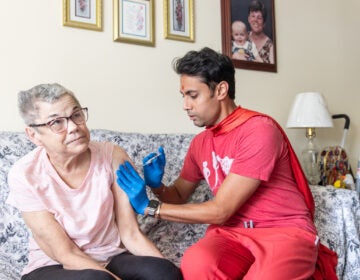Exercise is good for us. Even more so now that we’re stuck at home
We’re all a little stressed during these “stay-at-home” days. The health benefits of exercise can help counteract the impacts of isolation.

A runner at Ridge Avenue and Spring Garden Street on Tuesday, March 24, 2020. (Kimberly Paynter/WHYY)
Over the past two years, Catherine Ruiz had been going to the gym regularly, three to four times a week. All that changed recently, for obvious reasons.
“I stopped last Tuesday before the gym closed,” Ruiz said. “It was weird because it was really packed in some areas, to the point where I had to leave before I finished my workout. Something about so many people working out in there made it feel unsafe to me.”
Many nonessential businesses, fitness centers and gyms among them, have closed in recent days as a precautionary measure to slow the spread of the coronavirus and COVID-19. But for many people, staying in shape can be hard without that physical location.
“I’ve started working out at home. It sucks, it’s hard to feel motivated in a place where you usually rest,” Ruiz said. “Especially when you have to go outside and run in bad weather.”
Though you can’t get your regular sweat in at the gym for the time being, there are still ways to keep in shape during your time of social isolation. In fact, exercise might be an incredibly vital part of it.
“If you participate in regular exercise, it boosts your baseline immune system, making you less susceptible to various bacteria and viruses,” said Robert Mazzio, a researcher from the University of Colorado, Boulder.
Mazzio specializes in the metabolic and physiological effects of exercise on the human body. He said that exercise is not only good for your immune system, but it can also make your body more resilient to stress and can reduce anxiety.
“These are high-anxiety times, so people are very stressed out. They’re worried about getting sick, they’re worried about the financial implications. So, the other good news there is that … participation in regular exercise has been shown to reduce anxiety and depression and improve your state of mind.”
Exercise releases those feel-good endorphins that can help during these isolating and confusing times. But if you were going to the gym before and are having a tough time motivating at home, what can you do?
Many people have already started adjusting their routines to fit their new at-home reality.
“I’m isolated at home with my family, and every hour a timer goes off and we get up and we walk around the house,” said Chris Jordan, personal trainer and director of exercise physiology at the Johnson & Johnson Human Performance Institute. “At the very least, we walk up and down the stairs so that we all stay sane, that we all stay positive, that we stay energized.”
Jordan, along with Brett Klika, personal trainer and CEO of SPIDERfit Kids, designed and implemented the movement and exercise techniques in the widely known Johnson & Johnson 7-Minute Workout, or “The Scientific 7-Minute Workout.”
“It was developed for moms and dads, people who are extremely busy,” Klika said.
The goal was to develop something that was very simple, very easy to use and can be done anywhere in minutes.
“We wanted to make it accessible, so if you’re just getting started or if you’re a pro, it’s going to challenge you,” Klika added.
The original seven-minute workout is a series of 12 exercises that require your bodyweight only. Each exercise is performed for 30 seconds, then you move on to the next exercise very quickly, with only five seconds of rest or transition. The exercises are deliberately chosen in a specific sequence to maximize the effort you expend as well as the return.
“The first exercise will always be what I call a total body or more cardiovascular type exercise,” Jordan said. “For example, jumping jacks, followed by lower body like squats, upper body like pushups, and then core exercise like abdominal crunch. And then that pattern of four exercises is repeated two more times to total 12 exercises.”
Jordan and Klika offered options for at-home workouts that can be done without equipment. Here are some ways that they recommend we stay in shape and keep sane during these times.
Cardio
- If you’re able to do it, going out for a run is a great way to get some cardiovascular activity.
- Take a brisk walk. We may be social distancing, but we’re still allowed to be outside as long as we are not too close to other individuals and not in gatherings.
- If you’re going to go out for a run or a walk, interval training is recommended as a very time-efficient way of doing it. Interval training simply means alternating between fast running and slow running or fast walking and slow walking. And there’s alternating between the high and low to make the workout more efficient, more effective, more challenging, but in a manageable way.
- Walk around your house, or your apartment if you have space. Even getting up for a few minutes and walking around every hour can make a difference between having a good day and a bad day.
Bodyweight exercises
These exercises are ideal for the home environment because they require only minimal space.
- Squats
- Pushups
- Jumping jacks
- Burpees, also known as squat-thrusts
- Walking up and down the stairs
Flexibility/stretching
When you’re sitting for prolonged periods, your muscles can get tight. And when they get tight, you get aches and pains. Yoga and similar exercises can help restore flexibility, release some muscle tightness and make you feel better by helping you to relax.
With running or walking, bodyweight exercises, and yoga and flexibility, you have the three basic components for wellness exercise for cardiovascular muscle conditioning and stretching exercises.
At the very least, plan a time to move. Set a timer every 45 minutes and stand up, walk around the house, take five deep breaths, march in place, reach up overhead, touch the floor, and do five bodyweight squats. The demands on circulation created from moving drive oxygen and other nutrients to the brain. You’ll think clearer and feel better.
Free online resources
- BalletX is hosting free dance classes on Instagram.
- Corepower yoga is offering free online instructional videos.
- Freehouse Fitness Studio has started recording workouts. It will have a new one every day.
- Fuel Cycle Fitness is streaming free online classes on their Facebook group.
- Orangetheory Fitness has an endurance class that focuses on intervals and targeting certain zones of your heart rate. It uploads new at-home 30-minute workout routines daily.
- Rumble is hosting daily Instagram live videos featuring cardio and bodyweight workouts every morning.
- Tuck Barre & Yoga is live-streaming classes all day on Facebook.
- Unity Yoga is holding free online classes via its Instagram and Facebook live streams.
- Warhorse Barbell has a library of classes on its Instagram.
- YMCA is offering an online database of workouts.
- Yoga Home is hosting free live classes at noon on Zoom.
- Johnson & Johnson’s 7-minute workout app.
WHYY is your source for fact-based, in-depth journalism and information. As a nonprofit organization, we rely on financial support from readers like you. Please give today.


![CoronavirusPandemic_1024x512[1]](https://whyy.org/wp-content/uploads/2020/03/CoronavirusPandemic_1024x5121-300x150.jpg)



